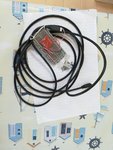QFour
Full Member
- Posts
- 4,046
- Likes
- 4,318
Yes Dave this what I'm doing. When the PTC goes into motor run mode I use this wire to operate a relay that switches two 12 volt fans over the cooling element. The down side is that the resistance in the relay coil winding messes with the PTC, so it's duty cycle changes. So when the compressor is running, so are the fans. What I'd like to do is run the fans via current sensing and better still have a delay to remove residual heat from the cooling element.
I'm tempted to try one of these as a switch.

0.2A~30A Adjustable AC Sensing Switch Current Sensing Switch (Normally Open) New | eBay UK
SZC23 series AC current sensing switch is designed and manufactured to solve the AC current monitoring. 1 Current Sensing Switch. The switch has no limit on the number of opening and closing, and the reaction speed reaches the ms level.www.ebay.co.uk
Being thick here what is a PTC ?
Last edited:

